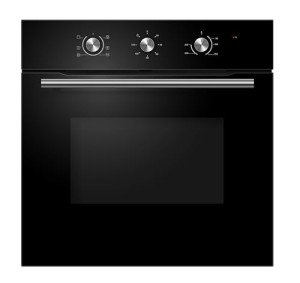The 3 Greatest Moments In Ovens Built In History

The Comprehensive Guide to Built-In Ovens: A Modern Kitchen Essential
Built-in ovens have become a staple in contemporary kitchens, combining looks, functionality, and space effectiveness into a single appliance. As homeowners aim for both usefulness and design, comprehending the functions, benefits, and considerations of built-in ovens can significantly improve the cooking experience. This article delves into what built-in ovens are, their different types, installation factors to consider, and FAQs to help consumers make notified choices.
What is a Built-In Oven?
A built-in oven is a kitchen device developed to be integrated into cabinetry, developing a smooth, cohesive look for the kitchen. Unlike freestanding ovens, which inhabit extra flooring space, built-in ovens are confined within wall units or cabinetry. They are available in various configurations and sizes, enabling tailored services that cater to the needs of diverse homes.
Types of Built-In Ovens
Built-in ovens can be categorized into different types based upon their functions and cooking approaches. Here are a few of the most common types:
Single Built-In Ovens
- Best for small cooking areas and homes with modest cooking needs.
- Normally have one primary cooking compartment, developing a compact footprint.
Double Built-In Ovens
- Ideal for avid cooks and larger households.
- Features 2 separate cooking compartments for versatile meal preparation.
Wall Ovens
- Set up at eye level for easy access.
- These ovens often feature convection innovation for even cooking results.
Steam Ovens
- Usage steam to prepare food, preserving moisture and nutrients.
- Great for health-conscious individuals.
Combination Ovens
- Merge microwave and conventional oven performances.
- Deal versatility for fast meals and traditional baking.
Italian or European Style Ovens
- Typically created with unique visual appeals and advanced cooking innovations.
- Popular for high-end kitchen designs.
Advantages of Built-In Ovens
Built-in ovens provide a variety of advantages that interest contemporary property owners looking for both functionality and aesthetics. Some of these benefits consist of:
- Space Efficiency: Built-in ovens save valuable counter space, which is particularly helpful in smaller kitchens.
- Enhanced Aesthetics: With a custom look, built-in ovens enhance the general design of the kitchen while supplying a seamless combination with kitchen cabinetry.
- Versatile Cooking Capacity: Available in numerous sizes, these ovens cater to the cooking requirements of various households, from single occupants to large households.
- Accessibility: The installation at eye level makes built-in ovens much easier to gain access to, decreasing the risk of spills or injuries when placing or getting rid of hot meals.
- Lower Energy Consumption: Many built-in ovens featured energy-efficient modes that assist reduce electric intake in time.
Setup Considerations
Installing a built-in oven requires cautious planning and factor to consider. Here are some aspects to remember:
- Dimensions: Before acquiring a built-in oven, measure the space offered to make sure a proper fit. Built-in ovens can be found in particular basic sizes, so it is crucial to choose the best one.
- Ventilation: Adequate ventilation is needed for effective operation. Make sure there is a proper exhaust system that complies with local building codes to avoid overheating.
- Electrical Requirements: Built-in ovens might need specific electrical outlets or electrical wiring. Seek advice from a qualified electrical expert to ensure that the setup adheres to safety standards.
- Professional Installation: Although some property owners select DIY installation, working with an expert can assist guarantee safety and right setup for optimal performance.
Maintenance Tips for Built-In Ovens
Keeping your built-in oven not just extends its life-span but likewise ensures efficient operation. Here are some necessary upkeep tips:
Regular Cleaning:
- Wipe down interior surfaces after each usage to avoid buildup.
- Usage vinegar and baking soda for non-toxic cleaning.
Inspect Seals:
- Inspect the door seals to avoid heat loss.
- Replace damaged seals without delay.
Test Thermostat:
- Periodically examine the temperature accuracy with an oven thermometer. Change settings as needed.
Service Annually:
- Schedule professional maintenance once a year to check electrical parts and guarantee safe operation.
| Upkeep Task | Frequency | Purpose |
|---|---|---|
| Tidy interior | After each use | Prevent buildup and odors |
| Examine seals | Regular monthly | Make sure no heat leaves |
| Test thermostat | Every 6 months | Examine temperature level accuracy |
| Professional service | Each year | Guarantee ideal efficiency |
FAQs About Built-In Ovens
1. Do built-in ovens can be found in various sizes?Yes, built-in ovens are available in various sizes to fit different kitchen setups and cooking requirements. It is necessary to determine the readily available area before purchasing. 2. Can built-in ovens be utilized as regular ovens?Absolutely. Built-in ovens function like regular ovens,
permitting you to bake, broil, and prepare a variety of dishes. 3. Are built-in ovens energy-efficient? Numerous built-in ovens come with energy-saving features and are designed to utilize less
electricity than freestanding models. 4. For how long does installation take?Installation time can differ based on complexity but usually ranges from 1 to 3 hours. It is advisable to hire a professional for optimum results. 5. What is the lifespan of a built-in oven?With proper upkeep, built-in ovens can last anywhere from 10 to 15 years or longer.
Built-in ovens use a wide variety of advantages for contemporary homes, combining benefit, energy performance, and stylish style into one service.
When picking and installing a built-in oven, it's important to consider the type that best fits your cooking routines, offered area, and visual preferences. By understanding helpful resources , setup requirements, and upkeep required, homeowners can raise their culinary experience and produce spectacular kitchens that impress both household and visitors alike. Purchasing a built-in oven can be a useful addition that streamlines cooking, improves home worth, and savors culinary delights for many years to come.

